 Since SF Playhouse allowed a few audience members sitting in a specially-designated area of the theatre to send Twitter messages during last Tuesday evening’s performance of The Fantasticks, an interesting debate about whether this activity should be allowed in the theatre or not has been going on on the Berkeley Repertory Theatre’s Facebook page.
Since SF Playhouse allowed a few audience members sitting in a specially-designated area of the theatre to send Twitter messages during last Tuesday evening’s performance of The Fantasticks, an interesting debate about whether this activity should be allowed in the theatre or not has been going on on the Berkeley Repertory Theatre’s Facebook page.
It seems that opinions are wildly divided on the subject. The detractors say that people should have their attention on the stage at all times and tweeting can wait till the intermission or after the show. The people who think tweeting should be allowed point out that it has the potential to engage and bring in new audiences. Bill English, SF Playhouse’s artistic director, said in the message thread on the Berkeley Rep Facebook page that the activity is no different from critics scribbling in notebooks all the way through shows, which I think is a very valid point.
I suppose I’m on the fence about the question. On the one hand, I find lit phone screens to be a distraction in a darkened theatre (the same goes for critics who use pen lights while writing in the dark.) And I do think that if a play is truly engaging, sending out tweets should be the last thing on an enraptured audience member’s mind. On the other hand, I don’t think it does any great harm, especially if the tweeters sit at the back of the theatre where their screens and tapping are likely to distract the minimum number of theatre-goers. And if it helps to engage people in new ways, then why not?

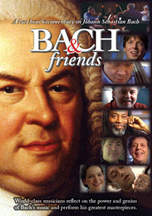 I love those spiraling evenings where you hop from one amazing arts event to another. Last night was epic. A brief summary:
I love those spiraling evenings where you hop from one amazing arts event to another. Last night was epic. A brief summary: This morning, I was interviewed by a couple of marketing consultants as part of a project aimed at helping them pull together a branding and messaging strategy for a local performing arts organization.
This morning, I was interviewed by a couple of marketing consultants as part of a project aimed at helping them pull together a branding and messaging strategy for a local performing arts organization.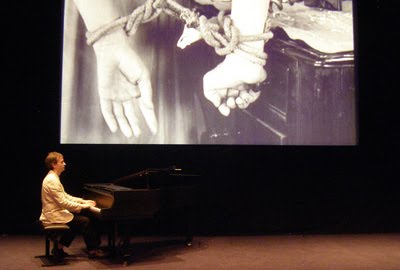 I’m preparing to present a panel on composing and performing music for silent films for the
I’m preparing to present a panel on composing and performing music for silent films for the 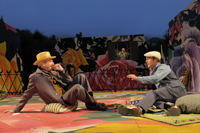 No summer in the Bay Area is complete without a trip to Orinda to experience a production and picnic at the
No summer in the Bay Area is complete without a trip to Orinda to experience a production and picnic at the 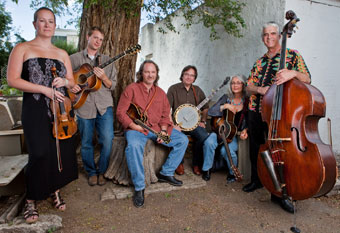 Experiencing the music of the progressive bluegrass outfit Hard Road is the equivalent of reading the poetry of Spike Milligan. Warm-hearted, yet with a mad professorly edge, the group tantalizes the eardrums with its homespun-streetwise blend of fast-strummed neo spirituals and folk songs.
Experiencing the music of the progressive bluegrass outfit Hard Road is the equivalent of reading the poetry of Spike Milligan. Warm-hearted, yet with a mad professorly edge, the group tantalizes the eardrums with its homespun-streetwise blend of fast-strummed neo spirituals and folk songs. A trip to Los Angeles on LA Times business and a friend visiting from London has kept me away from my blog for the last few days.
A trip to Los Angeles on LA Times business and a friend visiting from London has kept me away from my blog for the last few days.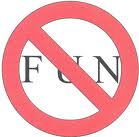 Since launching a non-profit arts project at the start of this year, I’ve been thinking about fundraisers quite a bit. I’ve attended a few for other organizations and I even mounted a modest one myself for my project last October in advance of the launch.
Since launching a non-profit arts project at the start of this year, I’ve been thinking about fundraisers quite a bit. I’ve attended a few for other organizations and I even mounted a modest one myself for my project last October in advance of the launch.
 The upcoming TechnoCRAFT exhibition at the
The upcoming TechnoCRAFT exhibition at the 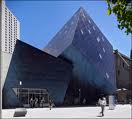 Yesterday, as we were standing in the vestibule/store at the
Yesterday, as we were standing in the vestibule/store at the  It’s hard to get the right balance with community music-making. As an oboist, I’ve played in groups which take themselves far too seriously and others which don’t take themselves seriously enough.
It’s hard to get the right balance with community music-making. As an oboist, I’ve played in groups which take themselves far too seriously and others which don’t take themselves seriously enough. Jan Kounen’s mostly insipid, exposition-laden feature film about the relationship between the 20th century’s greatest couturier and composer, Coco Chanel & Igor Stravinsky, is worth seeing for two reasons:
Jan Kounen’s mostly insipid, exposition-laden feature film about the relationship between the 20th century’s greatest couturier and composer, Coco Chanel & Igor Stravinsky, is worth seeing for two reasons: